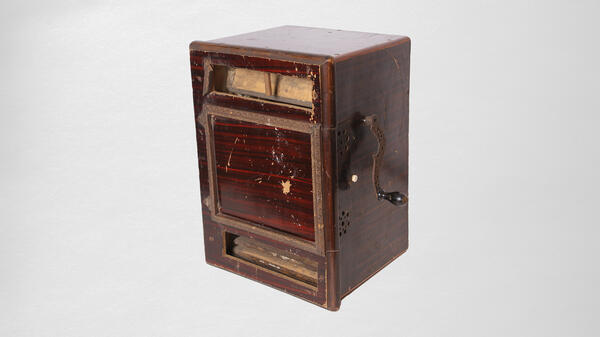In its design, the ancient barrel organ was somewhat reminiscent of a pipe organ. Inside the box, there were several rows of pipes, bellows and a wooden or metal barrel with cams — small protruding pins.
To make the barrel organ play, one had to turn a handle — a crank. It set in motion two mechanisms at once: the rod, which pumped air into the bellows at the bottom of the instrument, and the barrel with the pins. The barrel rotated, the pins caught special levers, and they opened and closed the air valves.
The barrel with pins embedded in it was a very important element of the instrument. These pins were placed in a certain order, which corresponded to the tune recorded. If the pins were rearranged, the music sounded differently. Usually six to eight tunes were placed on the barrel, which the musician could play sequentially. The sound of the instrument was often described as monotonous and sad.
Instruments similar to the barrel organ have been around since ancient times. The use of cam devices with protruded pins began in antiquity. This mechanism quickly became popular, so masters of different countries have been constantly improving it for many centuries.
Barrel organ came to Russia from Poland in the late 18th century, and the instrument was quickly adopted by travelling musicians and circus chapito artists. The most popular melody at the time was a song with the French name Charmant Katarina (‘Pretty Katarina’). Historians believe that in Russia, the instrument began to be called ‘sharmanka’ thanks to this tune. In the olden days, barrel organs were also called ‘katarinkas’.
Thanks to the wandering barrel organ players, the instrument grew in popularity in Russia very quickly.
In the 20th century, instead of barrels, perforated paper tapes began to be used: each hole on them corresponded to a certain sound. Often, barrel organs were designed so that their sound would be intermittent and shaky and, as a consequence, more pitiful.
To make the barrel organ play, one had to turn a handle — a crank. It set in motion two mechanisms at once: the rod, which pumped air into the bellows at the bottom of the instrument, and the barrel with the pins. The barrel rotated, the pins caught special levers, and they opened and closed the air valves.
The barrel with pins embedded in it was a very important element of the instrument. These pins were placed in a certain order, which corresponded to the tune recorded. If the pins were rearranged, the music sounded differently. Usually six to eight tunes were placed on the barrel, which the musician could play sequentially. The sound of the instrument was often described as monotonous and sad.
Instruments similar to the barrel organ have been around since ancient times. The use of cam devices with protruded pins began in antiquity. This mechanism quickly became popular, so masters of different countries have been constantly improving it for many centuries.
Barrel organ came to Russia from Poland in the late 18th century, and the instrument was quickly adopted by travelling musicians and circus chapito artists. The most popular melody at the time was a song with the French name Charmant Katarina (‘Pretty Katarina’). Historians believe that in Russia, the instrument began to be called ‘sharmanka’ thanks to this tune. In the olden days, barrel organs were also called ‘katarinkas’.
Thanks to the wandering barrel organ players, the instrument grew in popularity in Russia very quickly.
Sometimes they were accompanied by orphaned children who sang in pitiful voices and helped to earn more money. It was common for musicians to involve monkeys in their performances. To the sound of the songs, the animals made faces, somersaulted, and danced around. There were also barrel organs players with large parrots, who took rolled-up papers with predictions of the future out of boxes.
In the 20th century, instead of barrels, perforated paper tapes began to be used: each hole on them corresponded to a certain sound. Often, barrel organs were designed so that their sound would be intermittent and shaky and, as a consequence, more pitiful.



